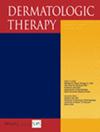A Novel Regimen of Transdermal Botulinum Toxin Delivery Using Fractional Microneedling Radiofrequency for Treatment of Erythema in Rosacea
IF 3.7
4区 医学
Q1 DERMATOLOGY
引用次数: 0
Abstract
Facial erythema is a representative symptom of rosacea patients that greatly impairs quality of life. Recently, the therapeutic effects of intradermal injection of botulinum toxin type-A on erythema have been investigated. Fractional microneedling radiofrequency has been reported to be effective in dermal remodeling and anti-inflammation. To obtain enhanced therapeutic effects with a less painful and easier approach, a treatment regimen using transdermal botulinum toxin delivery with fractional microneedling radiofrequency was developed. We aimed at investigating the efficacy and safety of transdermal botulinum toxin delivery with fractional microneedling radiofrequency in treating the erythema of rosacea. This was a retrospective review of 20 patients with facial erythema associated with rosacea. All patients underwent two sessions of treatment at 4-week intervals. Standardized photographs were taken, and the clinicians' erythema assessment (CEA), erythema index (EI) measured through a spectrophotometer, investigator’s global assessment (IGA), and subjective satisfaction and side effects were evaluated at the baseline and 4, 8, and 12 weeks after the baseline. Compared to the baseline, CEA levels significantly decreased after 8 weeks ( P = 0.018 ) and 12 weeks ( P = 0.005 ). As an objective measure, EI was observed to decrease significantly at 4 weeks ( P = 0.04 ) and 8 weeks after the baseline ( P = 0.005 ) compared with the baseline. Ninety-five percent of patients were either very satisfied or satisfied with the treatment. None of the patients experienced remarkable side effects. A novel treatment regimen involving transdermal botulinum toxin delivery and fractional microneedling radiofrequency may be an effective and safe option for reducing the facial erythema of rosacea.一种新的经皮肉毒杆菌毒素递送方案,使用射频微针治疗红斑酒渣鼻
面部红斑是酒渣鼻患者的典型症状,严重影响患者的生活质量。近年来,对皮内注射a型肉毒毒素治疗红斑的疗效进行了研究。据报道,射频微针在皮肤重塑和抗炎症方面有效。为了以更少的痛苦和更容易的方法获得增强的治疗效果,研究人员开发了一种使用经皮肉毒杆菌毒素的治疗方案。我们的目的是研究微针射频经皮肉毒毒素给药治疗酒渣鼻红斑的疗效和安全性。本研究是对20例伴有酒渣鼻的面部红斑患者进行回顾性分析。所有患者每隔4周接受两次治疗。拍摄标准化照片,并在基线和基线后4、8、12周评估临床医生的红斑评估(CEA)、分光光度计测量的红斑指数(EI)、研究者的整体评估(IGA)、主观满意度和副作用。与基线相比,CEA水平在8周(P = 0.018)和12周(P = 0.005)后显著下降。作为客观指标,EI在基线后4周(P = 0.04)和8周(P = 0.005)与基线相比显著降低。95%的患者对治疗非常满意或满意。所有患者都没有出现明显的副作用。一种新的治疗方案,包括经皮肉毒杆菌毒素输送和射频微针,可能是减少酒渣鼻面部红斑的有效和安全的选择。
本文章由计算机程序翻译,如有差异,请以英文原文为准。
求助全文
约1分钟内获得全文
求助全文
来源期刊

Dermatologic Therapy
医学-皮肤病学
CiteScore
7.00
自引率
8.30%
发文量
711
审稿时长
3 months
期刊介绍:
Dermatologic Therapy has been created to fill an important void in the dermatologic literature: the lack of a readily available source of up-to-date information on the treatment of specific cutaneous diseases and the practical application of specific treatment modalities. Each issue of the journal consists of a series of scholarly review articles written by leaders in dermatology in which they describe, in very specific terms, how they treat particular cutaneous diseases and how they use specific therapeutic agents. The information contained in each issue is so practical and detailed that the reader should be able to directly apply various treatment approaches to daily clinical situations. Because of the specific and practical nature of this publication, Dermatologic Therapy not only serves as a readily available resource for the day-to-day treatment of patients, but also as an evolving therapeutic textbook for the treatment of dermatologic diseases.
 求助内容:
求助内容: 应助结果提醒方式:
应助结果提醒方式:


